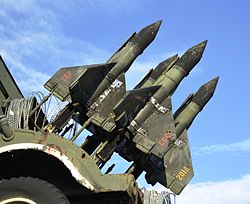3M6 Shmel

The 3M6 Shmel (Russian: 3М6 «Шмель»; English: bumblebee) is an MCLOS wire-guided Anti-tank missile of the Soviet Union. "3M6" is its GRAU designation. Its NATO reporting name is AT-1 Snapper.
Too large to be manportable, it was typically deployed from specialised vehicles or helicopters. The missile was intended to supplement traditional anti-tank weapons like the 100 mm anti-tank gun whose accuracy beyond 1500 m is poor. The missiles' accuracy in contrast remained high as far as its maximum range of 2000 m.
However the system's bulk, slow speed and poor combat accuracy drove development of later SACLOS systems like the AT-5 Spandrel.
Development
The 3M6 Shmel was based on the western ATGMs of the time such as the Nord Aviation SS.10, however it is considerably larger. It was developed by the Special Mortar Design Bureau (SKB Gladkostvolnoi artillerii) in Kolomna who were also responsible for the AT-3 Sagger.
Development of the missile proceeded rapidly, the first unguided flights in April 1958 followed by controlled flights in June and July 1958. On 28 August 1959, new technology was shown to the command of armed forces. On 1 August 1960 it was accepted into the service. It was first publicly displayed in 1963.
History


There were two ground based platforms for the missile
- 2P26 Based on the unarmored GAZ-69 light truck - with 4 launch rails pointing backwards. The control station can be deployed up to 30 m away from the launcher vehicle. Entered service in 1960
- 2P27 Based on the armored BRDM-1 - with 3 pop up launch rails protected by an armored cover. Entered service in 1964
These vehicles were deployed in anti-tank batteries attached to motor rifle regiments. Each battery has three platoons each with three launch vehicles and a single command BRDM.
It was used by Egyptian forces during the 1967 Six-Day War and attrition War from 1969. Few were used with only one tank loss attributed to the system. The hit probability for the system is estimated to have been 25% in combat.
The system was also used by the Cypriot National Guard during the 1974 Turkish Invasion of Cyprus in a man-portable version. Several dozen shots were fired in action during a number of July and August engagements in the conflict, with low effectiveness.
North Korea began producing a reverse-engineered version of the missile in 1975.
Description
The missile is guided to the target by means of a joystick, this requires some skill on the part of the operator. The operators adjustments are transmitted to the missile via a thin wire that trails behind the missile.
The missiles is steered by an unconventional arrangement of vibrating spoilers.
MCLOS requires considerable skill on the part of the operator. The systems effectiveness in combat drove the development of missiles based on the easier to use SACLOS system.
One problem with the missile is the amount of time it takes to reach maximum range—around twenty seconds—giving the intended target time to take action, either by retreating behind an obstacle, laying down a smoke screen or firing on the operator. Also the large size of the missile means that that only a few rounds can be carried; the BRDM-1 vehicle can only carry three missiles.
Operators
Current and past operators include:
- Afghanistan
- Bulgaria (former)
- Cuba
- Cyprus (former, combat user)
- Czechoslovakia (former)
- East Germany (former)
- Egypt
- Hungary
- Israel (captured from Egypt and Syria)
- Mongolia
- North Korea
- Poland (former)
- Romania
- USSR (former)
- Syria
- Yugoslavia (former) - 500
General characteristics
- Length: 1150 mm
- Wingspan: 750 mm
- Diameter: 136 mm
- Launch weight: 22.5 kg
- Speed: 90 to 110 m/s
- Range: 500 m to 2.3 km
- Time to maximum range: 20 seconds
- Guidance: wire-guided MCLOS
- Warhead: 5.4 kg HEAT 300 mm vs RHA
External links
- Gaz-69 Snapper - NATO codename for Gaz-69 fitted with Shmel ATGM (2P26 vehicle with 3M6 missiles of the Shmel ATGM system) – Walk around photos
- http://www.fas.org/man/dod-101/sys/land/row/at-1.htm
References
- Hull, A.W., Markov, D.R., Zaloga, S.J. (1999). Soviet/Russian Armor and Artillery Design Practices 1945 to Present. Darlington Productions. ISBN 1-892848-01-5.
- Jane's Weapon Systems 1977
- http://waronline.org/IDF/Articles/firstATGM.htm in Russian
